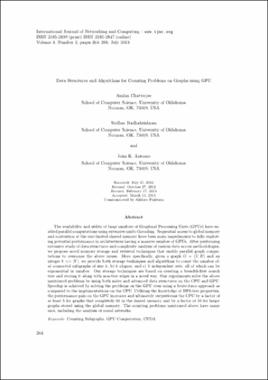| dc.contributor.author | Chatterjee, Amlan | |
| dc.contributor.author | Radhakrishnan, Sridhar | |
| dc.contributor.author | Antonio, John K. | |
| dc.date.accessioned | 2021-04-21T14:25:38Z | |
| dc.date.available | 2021-04-21T14:25:38Z | |
| dc.date.issued | 2013-07 | |
| dc.identifier.citation | Amlan Chatterjee, Sridhar Radhakrishnan, and John K. Antonio, “Data Structures and Algorithms for Counting Problems on Graphs using GPU,” International Journal of Networking and Computing (IJNC), Vol. 3, No. 2, July 2013, pp. 264-288. https://doi.org/10.15803/ijnc.3.2_264 | en_US |
| dc.identifier.uri | https://hdl.handle.net/11244/329482 | |
| dc.description.abstract | The availability and utility of large numbers of Graphical Processing Units (GPUs) have enabled parallel computations using extensive multi-threading. Sequential access to global memory and contention at the size-limited shared memory have been main impediments to fully exploiting potential performance in architectures having a massive number of GPUs. After performing extensive study of data structures and complexity analysis of various data access methodologies,we propose novel memory storage and retrieval techniques that enable parallel graph computations to overcome the above issues. More specifically, given a graph G= (V;E) and an integer k<=jVj, we provide both storage techniques and algorithms to count the number of:a) connected sub-graphs of size k; b)k cliques; and c)k independent sets, all of which can be exponential in number. Our storage techniques are based on creating a breadth- rst search tree and storing it along with non-tree edges in a novel way. Our experiments solve the above mentioned problems by using both naive and advanced data structures on the CPU and GPU.Speedup is achieved by solving the problems on the GPU even using a brute-force approach as compared to the implementations on the CPU. Utilizing the knowledge of BFS-tree properties,the performance gain on the GPU increases and ultimately outperforms the CPU by a factor of at least 5 for graphs that completely fit in the shared memory and by a factor of 10 for larger graphs stored using the global memory. The counting problems mentioned above have many uses, including the analysis of social networks. | en_US |
| dc.language | en_US | en_US |
| dc.subject | Counting Subgraphs | en_US |
| dc.subject | GPU Computation | en_US |
| dc.subject | CUDA | en_US |
| dc.title | Data Structures and Algorithms for Counting Problems on Graphs using GPU | en_US |
| dc.type | Article | en_US |
| dc.description.peerreview | Yes | en_US |
| dc.identifier.doi | 10.15803/ijnc.3.2_264 | en_US |
| ou.group | Gallogly College of Engineering::School of Computer Science | en_US |
